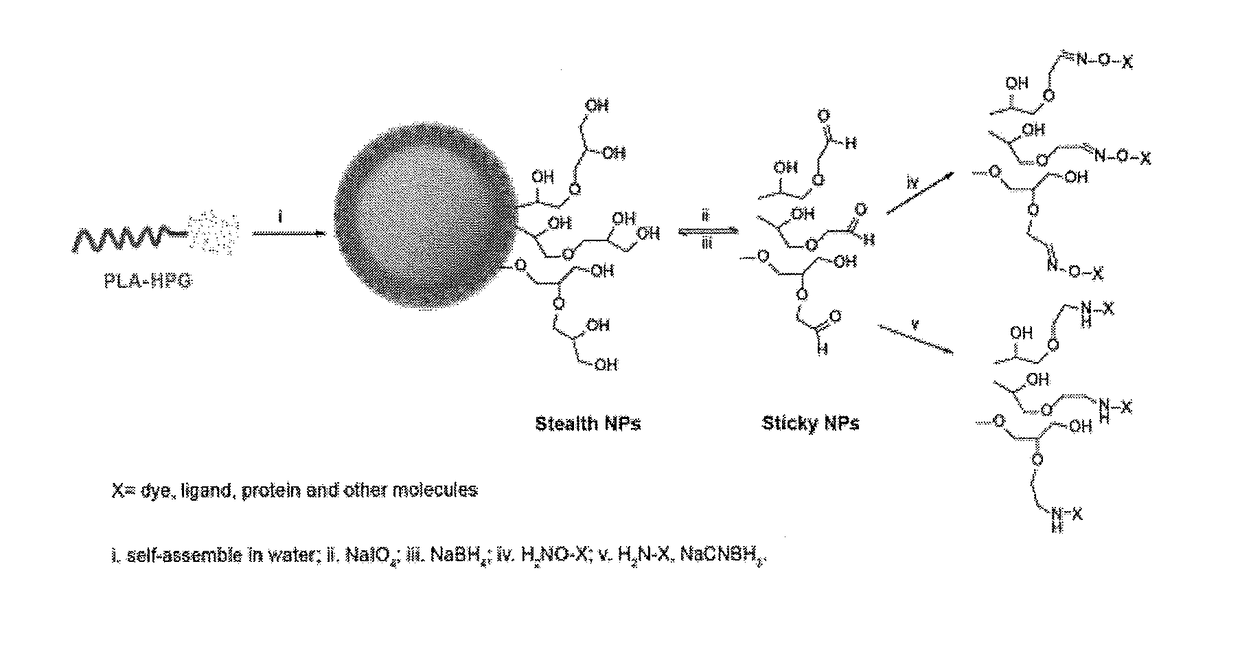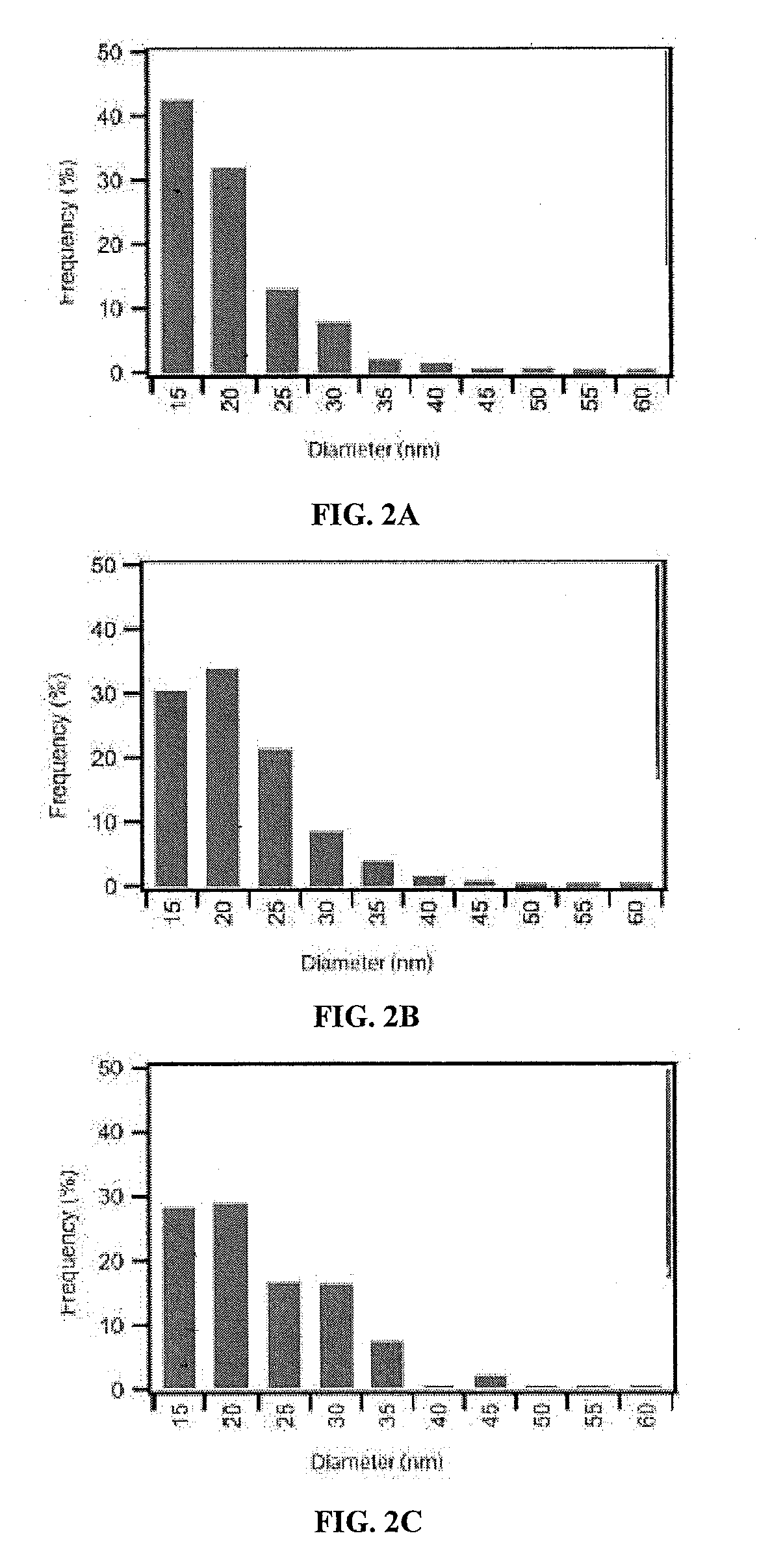Hyperbranched polyglycerol-coated particles and methods of making and using thereof
a polyglycerol coating and hyperbranched technology, applied in the field of particles, can solve the problems of limiting the ability of non-liver targets of nps to ensure delivery, rapid loss of nps and their associated drugs from circulation, and inability to ensure delivery
- Summary
- Abstract
- Description
- Claims
- Application Information
AI Technical Summary
Benefits of technology
Problems solved by technology
Method used
Image
Examples
example 1
[0222]Hyperbranched polyglycerol (HPG) was synthesized by anionic polymerization. Briefly, 4.6 mmol 1,1,1-trihydroxypropane (THP) was added into an argon protected flask in a 95° C. oil bath and 1.5 mmol KOCH3 was added. The system was hooked up to a vacuum pump and left under vacuum for 30 min. The system was refilled with argon and 25 ml glycidol was added by a syringe pump over 12 hours. The HPG was dissolved in methanol and precipitated by addition of acetone. HPG was purified 2-3 times with methanol / acetone precipitation. To further remove the low molecular weight HPG, 2-5 ml HPG was placed in a 10 ml dialysis tube (0.5-1 k cut-off) and dialyzed against deionized (DI) water. The water was replaced two times every 12 hours. HPG was precipitated with acetone and then dried under vacuum at 80° C. for 12 h.
example 2
of PLA-HPG and PLA-PEG Copolymers
[0223]PLA (5 g) and 2.15 g HPG were dissolved in dimethyl formamide (DMF) and dried over molecular sieves overnight. 0.06 ml diisopropylcarboimide (DIC) and 10 mg 4-(N,N-dimethylamino)pyridine (DMAP) were added and the reaction proceeded for 5 days at room temperature under stirring. The product was precipitated by pouring the reaction into cold diethyl ether (ether) and collecting the precipitate by centrifugation. The product was redissolved in dichloromethane (DCM) and precipitated again with a cold mixture of ether and methanol. The product was washed with a cold mixture of ether and methanol. The polymer was dried under vacuum for 2 days.
[0224]To synthesize PLA-PEG, 2.6 g PLA and 1.0 g MPEG-NH2 were dissolved in DMF and dried over molecular sieves overnight. 0.038 ml DIC was added and the reaction proceeded for 2 days at room temperature under stirring. The product was precipitated by pouring the reaction into cold ether and collecting the preci...
example 3
on of Nanoparticles (NPs)
[0225]Fifty mg of PLA-HPG copolymer dissolved in 1.5-3.0 ml of ethyl acetate / dimethyl sulfoxide (DMSO) (4:1) was added to 4 ml DI water under vortexing and subjected to probe sonication for 3 cycles at 10 sec each. The resulting emulsion was diluted in 20 ml DI water under stirring. It was stirred for at least 5 hours or attached to a ratovapor to evaporate the ethyl acetate and then applied to an AMICO® ultra centrifuge filtration unit (100 k cut-off). The NPs were washed by filtration 2 times then suspended in a 10% sucrose solution. The NPs were kept frozen at −20° C.
[0226]The PLA-PEG NPs were made using a single emulsion technique. 50 mg PLA-PEG copolymer dissolved in 1.5-3.0 ml ethyl acetate / DMSO (4:1) was added to 4 ml DI water with 2.5% PVA under vortexing and subjected to probe sonication for 3 cycles of 10 sec each. The resulting emulsion was diluted in 20 ml DI water with 0.1% TWEEN® 80 with stirring. The emulsion was stirred for at least 5 hours o...
PUM
| Property | Measurement | Unit |
|---|---|---|
| diameter | aaaaa | aaaaa |
| diameter | aaaaa | aaaaa |
| diameter | aaaaa | aaaaa |
Abstract
Description
Claims
Application Information
 Login to View More
Login to View More - R&D
- Intellectual Property
- Life Sciences
- Materials
- Tech Scout
- Unparalleled Data Quality
- Higher Quality Content
- 60% Fewer Hallucinations
Browse by: Latest US Patents, China's latest patents, Technical Efficacy Thesaurus, Application Domain, Technology Topic, Popular Technical Reports.
© 2025 PatSnap. All rights reserved.Legal|Privacy policy|Modern Slavery Act Transparency Statement|Sitemap|About US| Contact US: help@patsnap.com



